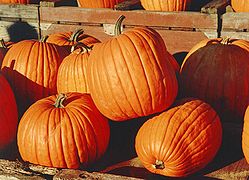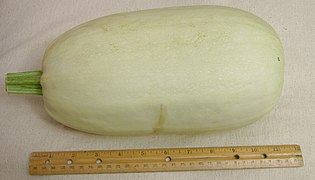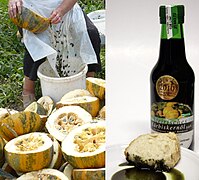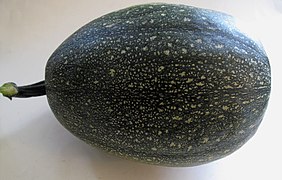Cucurbita pepo
| Cucurbita pepo | |
|---|---|

| |
| Assorted cultivars, from top-left, clockwise: pattypan squash, yellow summer squash, a large zucchini (or marrow), and pumpkins | |
| Scientific classification | |
| Kingdom: | Plantae |
| Clade: | Tracheophytes |
| Clade: | Angiosperms |
| Clade: | Eudicots |
| Clade: | Rosids |
| Order: | Cucurbitales |
| Family: | Cucurbitaceae |
| Genus: | Cucurbita |
| Species: | C. pepo
|
| Binomial name | |
| Cucurbita pepo | |
| Synonyms[2] | |
| |
Cucurbita pepo is a cultivated plant of the genus Cucurbita. It yields varieties of winter squash and pumpkin, but the most widespread varieties belong to the subspecies Cucurbita pepo subsp. pepo, called summer squash.[3]
It has been domesticated in the Americas for thousands of years.[4] Some authors maintain that C. pepo is derived from C. texana, while others suggest that C. texana is merely feral C. pepo.[5] They have a wide variety of uses, especially as a food source and for medical conditions. C. pepo seems more closely related to C. fraterna, though disagreements exist about the exact nature of that connection, too.[6]
It is a host species for the melonworm moth, the squash vine borer, and the pickleworm. They are also the preferred pollen for squash bees.
Taxonomy[]
The morphological differences within the species C. pepo are so vast that its various subspecies and cultivars have been misidentified as totally separate species. These vast differences are rooted in its widespread geographic distribution.[6] C. pepo is one of the oldest, if not the oldest domesticated species.[5][7][8] The oldest known locations are in southern Mexico in Oaxaca 8,000–10,000 years ago and Ocampo, Tamaulipas, Mexico about 7,000 years ago.[5][7][8] Its ancient territory extended north into Texas and up the Greater Mississippi River Valley into Illinois and east to Florida, and possibly even to Maine.[6] It is one of several plants cultivated in prehistoric North America as part of the Eastern Agricultural Complex. It is known to have appeared in Missouri at least 4,000 years ago.[9] Some varieties grow in arid regions and some in moist regions.[6]
Debates about the origin of C. pepo have been going on since at least 1857.[10] Traditionally, two opposing theories are given about its origin: 1) C. pepo is a direct descendant of C. texana and 2) C. texana is feral C. pepo.[5] A more recent theory is that C. pepo is a descendant of C. fraterna and hybridized with C. texana;[11] resulting in two distinct domestication events in two different areas: one in Mexico and one in the eastern United States, with C. fraterna and C. texana, respectively, as the ancestral species.[9][11][12][13] C. pepo may have appeared in the Old World prior to moving from Mexico into South America.[9]
It is found from sea level to slightly above 2,000 m (6,600 ft). Leaves have three to five lobes and are 20–35 cm wide. All the subspecies, varieties, and cultivars are conspecific and interfertile. Random amplified polymorphic DNA has proven useful in sorting out the relationships of the C. pepo species, varieties, and cultivars, showing that few, if any, modern cultivars have their origins with C. texana. They are associated with C. fraterna or a still unknown ancestral specimen in southern Mexico.[6]
Wild C. pepo is still found in the same areas as C. fraterna in Mexico. Their isozymes are very similar. C. pepo has more similarities to C. fraterna than it does to C. texana, which is also claimed to be an ancestor of C. pepo. All studied C. fraterna alleles are also found in C. pepo.[11] Consequently, C. fraterna is the nearest relative of C. pepo. C. pepo is most likely an early domesticated form of C. fraterna. It crosses well with both C. pepo and C. texana. Unlike most wild Cucurbita species, some fruit specimens of C. fraterna have been found that were not bitter. Its usual habitat is dry upland scrub areas. C. pepo could be a compilospecies of C. fraterna and C. texana, which appear to be two species that were originally separate.[11][12] Based on genetic allele analysis, two distinct groups occur within C. pepo: pumpkin, calabaza, criolla, and marrow squash are in one; and ornamental gourds, crookneck, acorn, scallop, and a few others in the second one. C. fraterna is genetically closer to the first group and C. texana is genetically closer to the second group.[13][14] Ornamental gourds found in Texas are called var. texana and those found outside of Texas (Illinois, Missouri, Arkansas, Oklahoma, and Louisiana) are called var. ozarkana.[8] In a 1989 study on the origins and development of C. pepo, Paris suggested that the original wild specimen was a small round fruit and that the modern pumpkin is its direct descendant. He also suggested that the crookneck, ornamental gourd, and scallop are early variants, and that the acorn is a cross between the scallop and pumpkin.[15]
Several taxa have been proposed, but as of 2012 none has been universally accepted.[16] In 2002, the taxa conventions proposed by Decker-Walters were:[6]
- C. pepo subsp. pepo - cultivated pumpkins, marrows, the orange gourds ("Orange Ball" and "Orange Warted")
- C. pepo subsp. ovifera var. ovifera – cultivated crooknecks, scallops, acorns, most ornamental gourds
- C. pepo subsp. ovifera var. ozarkana – wild populations in the Greater Mississippi Valley and Ozark Plateau
- C. pepo subsp. ovifera var. texana – wild populations in Texas
- C. pepo subsp. fraterna – wild populations in northeastern Mexico
A 2003 study recognized three subspecies:[17]
- Cucurbita pepo subsp. fraterna
- Cucurbita pepo subsp. pepo
- Cucurbita pepo subsp. texana
In 1986, botanist Paris proposed a taxonomy of C. pepo consisting of eight edible groups based on their basic shape.[15][18] All but a few C. pepo cultivars can be included in these groups.[18] These eight edible cultivated varieties of C. pepo vary widely in shape and color,[9][19][20] and one inedible cultivated variety:[21]
| Cultivar group | Botanical name | Image | Description |
|---|---|---|---|
| Acorn | C. pepo var. turbinata |  |
winter squash, both a shrubby and creeping plant, obovoid or conical shape, pointed at the apex and with longitudinal grooves, thus resembling a spinning top,[18] ex: Acorn squash[9][19][20] |
| Cocozelle | C. pepo var. ionga |  |
summer squash, long round slender fruit that is slightly bulbous at the apex,[18] similar to fastigata, ex: [9][19][20] |
| Crookneck | C. pepo var. torticollia |  |
summer squash, shrubby plant, with yellow, golden, or white fruit which is long and curved at the end and generally has a verrucose (wart-covered) rind,[18] ex: Yellow crookneck squash[9][19][20] |
| Pumpkin | C. pepo var. pepo |  |
winter squash, creeping plant, round, oblate, or oval shape and round or flat on the ends,[18] ex: Pumpkin;[9][19][20] includes C. pepo subsp. pepo var. styriaca, used for Styrian pumpkin seed oil[22] |
| Scallop | C. pepo var. clypeata; called C. melopepo by Linnaeus[6] |  |
summer squash, prefers half-shrubby habitat, flattened or slightly discoidal shape, with undulations or equatorial edges,[18] ex: Pattypan squash[9][19][20] |
| Straightneck | C. pepo var. recticollis |  |
summer squash, shrubby plant, with yellow or golden fruit and verrucose rind, similar to var. torticollia but a stem end that narrows,[18] ex: Yellow summer squash[9][19][20] |
| Vegetable marrow | C. pepo var. fastigata |  |
summer and winter squashes, creeper traits and a semi-shrub, cream to dark green color, short round fruit with a slightly broad apex,[18] ex: Spaghetti squash (a winter variety)[9][19][20] |
| Zucchini (US) Courgette (UK, IE) |
C. pepo var. cylindrica | summer squash, presently the most common group of cultivars, origin is recent (19th century), semi-shrubby, cylindrical fruit with a mostly consistent diameter,[18] similar to fastigata, ex: Zucchini[9][19][20] | |
| Ornamental gourds | C. pepo var. ovifera |  |
non-edible,[21] field pumpkins closely related to C. texana, vine habitat, thin stems, small leaves, three sub-groups: C. pepo var. ovifera (egg-shaped, pear-shaped), C. pepo var. aurantia (orange color), and C. pepo var. verrucosa (round warty gourds), ornamental gourds found in Texas and called var. texana and ornamental gourds found outside of Texas (Illinois, Missouri, Arkansas, Oklahoma, and Louisiana) are called var. ozarkana.[8] |
Description[]
Due to their varied genetic background, members of C. pepo vary widely in appearance, primarily in regards to their fruits. The plants are typically 1.0–2.5 feet high, 2–3 feet wide, and have yellow flowers.[23] Within C. pepo, the pumpkins, scallops, and possibly crooknecks are ancient and were domesticated separately. The domesticated species have larger fruits and larger yet fewer seeds.[15] Parthenocarpy is known to occur in certain cultivars of C. pepo.[24][25]
Cultivars[]
C. pepo includes a wide assortment of varieties and cultivars:[5]
- Acorn squash
- Delicata squash
- Dodi marrow, grown in South Asia[26]
- Gem squash
- Heart of gold squash
- Kamo kamo, also called kumi kumi, an heirloom summer and winter squash grown by the Māori people of New Zealand[27]
- Several types of ornamental squash (often called "gourds")
- Pattypan squash
- Several types of pumpkin
- Spaghetti squash
- Sweet dumpling squash
- Yellow crookneck squash
- Yellow summer squash
- Zucchini, also known as courgette (or [vegetable] marrow cultivar)
Uses[]
It is an ingredient in "schumaakwe cakes" and is used externally for rheumatism and swelling. A poultice of seeds and blossoms is applied to cactus scratches.[28] Fresh squash is cut into spiral strips, folded into hanks and hung up to dry for winter use. The blossoms are cooked in grease[clarification needed] and used as a delicacy in combination with other foods. Fresh squash, either whole or in pieces, is roasted in ashes and used for food. The gourds can be made into cups, ladles, and dippers and put to various uses.[29] The gourds are also worn[by whom?] in phallic dances symbolizing fructification or made into ceremonial rattles. Gourds are also made into receptacles for storing precious articles.[30]
Gallery[]

'Delicata' squash

Connecticut Field variety

Spaghetti squash

C. pepo var. styriaca

Male flower of zucchini

Detail of flower

Baby zucchini

Wild C. pepo subsp. ovifera var. ozarkana

Accidental hybrid of two varieties of C. pepo
References[]
- ^ Castellanos Morales, G., Sánchez de la Vega, G., Aragón Cuevas, F., Contreras, A. & Lira Saade, R. 2019. Cucurbita pepo. The IUCN Red List of Threatened Species 2019: e.T20742885A20755901. https://dx.doi.org/10.2305/IUCN.UK.2019-2.RLTS.T20742885A20755901.en. Downloaded on 25 October 2021.
- ^ The Plant List, Cucurbita pepo
- ^ "Cucurbita pepo L. field pumpkin". United States Department of Agriculture. Retrieved August 26, 2013.
- ^ "Cucurbits". Purdue University. Retrieved August 26, 2013.
- ^ a b c d e Nee, Michael (1990). "The Domestication of Cucurbita (Cucurbitaceae)". Economic Botany. New York: New York Botanical Gardens Press. 44 (3, Supplement: New Perspectives on the Origin and Evolution of New World Domesticated Plants): 56–68. doi:10.1007/BF02860475. JSTOR 4255271. S2CID 40493539.
- ^ a b c d e f g Decker-Walters, Deena S.; Staub, Jack E.; Chung, Sang-Min; Nakata, Eijiro; Quemada, Hector D. (2002). "Diversity in Free-Living Populations of Cucurbita pepo (Cucurbitaceae) as Assessed by Random Amplified Polymorphic DNA". Systematic Botany. American Society of Plant Taxonomists. 27 (1): 19–28. JSTOR 3093892.
- ^ a b Gibbon, Guy E.; Ames, Kenneth M. (1998). Archaeology of Prehistoric Native America: An Encyclopedia. New York: Routledge. p. 238. ISBN 978-0-815-30725-9.
- ^ a b c d "Free-living Cucurbita pepo in the United States Viral Resistance, Gene Flow, and Risk Assessment". Texas A&M Bioinformatics Working Group. Retrieved September 8, 2013.
- ^ a b c d e f g h i j k l Saade, R. Lira; Hernández, S. Montes. "Cucurbits". Purdue Horticulture. Retrieved September 2, 2013.
- ^ Kirkpatrick, Kurt J.; Wilson, Hugh D. (1988). "Interspecific Gene Flow in Cucurbita: C. texana vs. C. pepo". American Journal of Botany. Botanical Society of America. 75 (4): 519–527. doi:10.2307/2444217. JSTOR 2444217.
- ^ a b c d Andres, Thomas C. (1987). "Cucurbita fraterna, the Closest Wild Relative and Progenitor of C. pepo". Cucurbit Genetics Cooperative Report. Raleigh, NC: North Carolina State University. 10: 69–71.
- ^ a b Sanjur, Oris I.; Piperno, Dolores R.; Andres, Thomas C.; Wessel-Beaver, Linda (2002). "Phylogenetic Relationships among Domesticated and Wild Species of Cucurbita (Cucurbitaceae) Inferred from a Mitochondrial Gene: Implications for Crop Plant Evolution and Areas of Origin". Proceedings of the National Academy of Sciences of the United States of America. Washington, DC: National Academy of Sciences. 99 (1): 535–540. Bibcode:2002PNAS...99..535S. doi:10.1073/pnas.012577299. JSTOR 3057572. PMC 117595. PMID 11782554.
- ^ a b Soltis, Douglas E.; Soltis, Pamela S. (1990-05-31). Isozymes in Plant Biology. London: Dioscorodes Press. p. 176. ISBN 0-412-36500-6.
- ^ Smith, Bruce D. (1992). Rivers of Change: Essays on Early Agriculture in Eastern North America. Tuscaloosa, AL: University of Alabama Press. pp. 71–73. ISBN 978-0-8173-5425-1.
- ^ a b c Paris, Harry S. (1989). "Historical Records, Origins, and Development of the Edible Cultivar Groups of Cucurbita pepo (Cucurbitaceae)". Economic Botany. New York Botanical Garden Press. 43 (4): 423–443. doi:10.1007/bf02935916. JSTOR 4255187. S2CID 29052282.
- ^ Lim, T. K. (2012). Edible Medicinal And Non-Medicinal Plants. 2, Fruits. Netherlands: Springer. p. 292. doi:10.1007/978-94-007-1764-0. ISBN 978-94-007-1763-3. S2CID 52803602.
- ^ Paris, H. S.; Yonash, N.; Portnoy, V.; Mozes-Daube, N.; Tzuri, G.; Katzir, N. (April 2003). "Assessment of Genetic Relationships in Cucurbita pepo (Cucurbitaceae) Using DNA Markers". Theor. Appl. Genet. 106 (6): 971–978. doi:10.1007/s00122-002-1157-0. PMID 12671744. S2CID 21609254.
- ^ a b c d e f g h i j Paris, Harry S. (1986). "A Proposed Subspecific Classification for Cucurbita pepo". Phytologia. Bronx Park. 61 (3): 133–138.[permanent dead link]
- ^ a b c d e f g h i "Cucurbita pepo". Missouri Botanical Garden. Retrieved September 2, 2013.
- ^ a b c d e f g h i Heistinger, Andrea (2013). The Manual of Seed Saving: Harvesting, Storing, and Sowing Techniques for Vegetables, Herbs, and Fruits. Portland, OR: Timber Press. p. 278. ISBN 978-1-60469-382-9.
- ^ a b Decker, Deena S.; Wilson, Hugh D. (1987). "Allozyme Variation in the Cucurbita pepo Complex: C. pepo var. ovifera vs. C. texana". Systematic Botany. American Society of Plant Taxonomists. 12 (2): 263–273. doi:10.2307/2419320. JSTOR 2419320.
- ^ Fürnkranz, Michael; Lukesch, Birgit; Müller, Henry; Huss, Herbert; Grube, Martin; Berg, Gabriele (2012). "Microbial Diversity Inside Pumpkins: Microhabitat-Specific Communities Display a High Antagonistic Potential Against Phytopathogens". . Springer. 63 (2): 418–428. doi:10.1007/s00248-011-9942-4. JSTOR 41412429. PMID 21947430. S2CID 16454305.
- ^ "Cucurbita pepo". Missouri Botanical Garden. Retrieved August 26, 2013.
- ^ Robinson, R. W.; Reiners, Stephen (July 1999). "Parthenocarpy in Summer Squash" (PDF). HortScience. 34 (4): 715–717. doi:10.21273/HORTSCI.34.4.715.
- ^ Menezes, C. B.; Maluf, W. R.; Azevedo, S. M.; Faria, M. V.; Nascimento, I. R.; Gomez, L. A.; Bearzoti, E. (March 2005). "Inheritance of Parthenocarpy in Summer Squash (Cucurbita pepo L.)". Genetics and Molecular Research. 4 (1): 39–46. PMID 15841434.
- ^ Spreading the word on vegetables Archived 2011-09-04 at the Wayback Machine, Coventry Telegraph, Mar 10 2008. Retrieved September 5, 2010.
- ^ "Heirloom Summer Squash at the Kerr Center". The Kerr Center for Sustainable Agriculture. Retrieved 15 May 2013.
- ^ Stevenson, Matilda Coxe, 1915, Ethnobotany of the Zuni Indians. SI-BAE Annual Report #30 (pp. 45–46)
- ^ Stevenson, p. 67
- ^ Stevenson, p. 88
External links[]
| Wikimedia Commons has media related to Cucurbita pepo. |
| Wikispecies has information related to Cucurbita pepo. |
- IUCN Red List least concern species
- Cucurbita
- Plants used in traditional Native American medicine
- Crops originating from Pre-Columbian North America
- Squashes and pumpkins
- Plants described in 1753
- Taxa named by Carl Linnaeus











